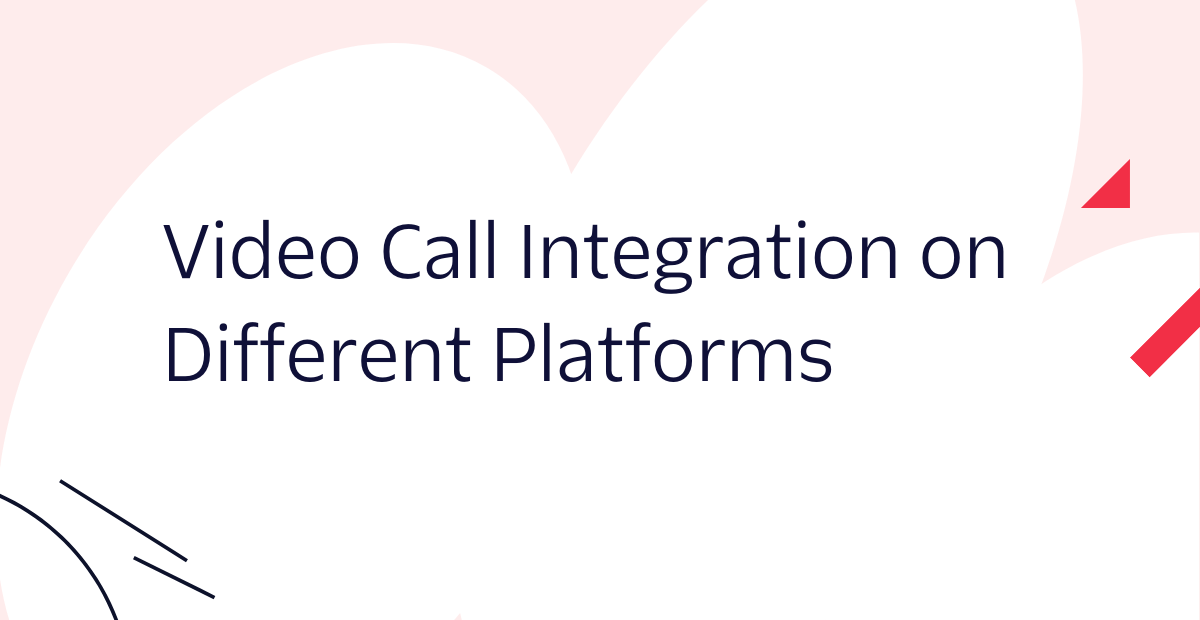Video Call Integration on Different Platforms
Time to read: 3 minutes

You probably don’t need us to tell you how prevalent video calls have become. After all, you’ve likely relied on this communication channel recently, whether it’s for a work meeting or a personal matter.
We can’t deny the benefits across industries. Businesses now use video for all types of communications, including sales calls, healthcare consultations, education, recruiting and hiring, and live-event streaming—and it’s clear why.
Third-party video calling platforms are handy for remote work and internal communications. But when it comes to client or patient interactions, integrating a custom video application with your existing platforms enables seamless communication with your customers.
This post will cover the benefits of audio and video integration and how to build a custom video calling app.
Why integrate video on your platform?
Video offers an immediacy and personal touch to your communications that other channels, like email or chat, can’t match. Some of the benefits of video include:
- In a Lifesize report, 51% of respondents said that companies are more innovative when they use video calling. Also, 55% of respondents see these companies as more collaborative, and 31% see them as more successful.
- In the healthcare industry, video calling saves time and travel costs for both practitioners and patients. It also helps reduce the number of people at healthcare facilities.
- In sales, video calling can improve conversion and retention rates. It allows clearer communication by incorporating signals that convey intention and meaning, such as facial expressions and tone of voice.
Building a video calling app allows you to connect with customers without having to take your conversations onto a third-party app or website. With application programming interfaces (APIs) and software development kits (SDKs), you can create a video solution customized to your needs and integrate it with just a few lines of code.
How to integrate video calling
There are a few ways to approach your video solution, depending on whether you want to build an app or deploy and customize an open-source app. Below are the first steps and some tutorials to get you started.
1. Choose a platform
The quickest way to get your video app up and running is to rely on APIs and SDKs customizable to meet your needs. A cloud-based communications platform like Twilio provides these as well as reference apps and all the documentation you or your developers will need to build your custom solution.
2. Find the right SDK
Whether you’re adding video to a website, an application, or both, you’ll need the right SDK. SDKs are the tools that facilitate your application build, and each one is specific to a particular development platform. Twilio provides SDKs for the web (JavaScript) as well as Android and iOS for mobile video integration.
3. Build or deploy your video app
Now is the time to choose: Would you like to build an app or deploy an existing open-source app and customize it to your use case? Whatever your choice, here are some resources to set you on the right path.
A. Build an app
Building a video app gives you the flexibility to create the exact solution your business needs. Explore our tutorials for building video apps in a variety of programming languages and integrating video with other collaboration tools:
- Build a Free 1:1 Video Chat Application With Twilio WebRTC Go and JavaScript
- Build a Video Chat With React Hooks
- Co-Browse a Shared Notepad in Real Time With Twilio Sync and Programmable Video
- Build a Serverless Video Chat Application With JavaScript and Twilio Programmable Video
- Screen Sharing With JavaScript and Twilio Programmable Video
- Build a Video API with Twilio Programmable Video, Node.js, TypeScript, and Express
B. Deploy an open-source app
If you’re looking for a straightforward video solution and want to deploy your app quickly, check out these open-source video collaboration applications for iOS, Android, and the web.
These video apps include screen sharing and monitoring network conditions and are adaptable for various industries like healthcare and education. Plus, you can deploy these fully functional video apps to the cloud in a matter of minutes. Once you deploy the app and give it a try, you can take a deeper dive and customize the app to your specific use case.
Integrate video for your platform with Twilio
Ready to build your one-of-a-kind video application? With Twilio Video, you can create a tailored video experience and even use custom virtual backgrounds and layouts that seamlessly integrate with your brand. Learn more about Twilio Video and sign up to try it for free.
Related Posts
Related Resources
Twilio Docs
From APIs to SDKs to sample apps
API reference documentation, SDKs, helper libraries, quickstarts, and tutorials for your language and platform.
Resource Center
The latest ebooks, industry reports, and webinars
Learn from customer engagement experts to improve your own communication.
Ahoy
Twilio's developer community hub
Best practices, code samples, and inspiration to build communications and digital engagement experiences.


